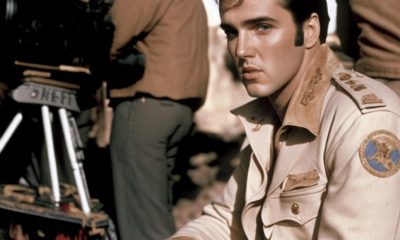Life
6 Unusual Exercises to Effectively Increase Your Creativity Faster Than Ever

Although a vast majority of people think that creativity is something you are born with, the truth is a bit different. While we cannot deny that you need natural talent to a certain extent, stimulating creative thinking is indeed a matter of practice. If you give this thought a bit of thinking, you can realize pretty quickly that even the most fascinating and creative minds have faced the lack of creativity at some point in their lives.
Here are 6 effective exercises to increase creativity easily and faster than ever:
1. Finish the given picture
As the name suggests, this exercise involves getting a simple unfinished picture you need to complete yourself. The method has been used widely since the 1960s and has proven to be very helpful when you need to increase your creativity. It is fascinating to see how a few simple lines and shapes can inspire you to create a completely new picture.
Moreover, the method is highly helpful when you feel the pressure or the consequences of burnout. Taking your mind and thoughts off the burning issues and creating something surprisingly imaginative and eye catching will boost your confidence and your enthusiasm will make a difference.
2. Turn your whole world upside down
When you need to increase your creativity, it helps considerably to observe the items in your surroundings from a different perspective. For example, choose a picture of a person’s face. Then, do your best to draw the face upside-down. Although it might feel a bit unusual in the beginning, the aim of this exercise is to focus on lines, shapes, and colors instead of concentrating on presenting the face as realistic as you can.
Generally, leaving the tried and trusted methods and breaking out of your comfort zone motivates the brain to work intensively, make connections between items, and identify new patterns. Eventually, this practice cannot but result in new creative ideas and improved creativity as a whole.
“You can’t wait for inspiration, you have to go after it with a club.” – Jack London
3. What is it like to choose quantity over quality?
Not seldom are we said that choosing quality over quantity is always the right thing to do. However, when you feel stuck in a creative dead end, the opposite tactic is highly helpful. One of the exercises to increase your creativity involves 20-30 blank circles on a piece of paper, 2-3 minutes of your time, and a pencil. Your task is to fill in these circles with as many drawings as possible.
The aim of this exercise is to realize that in certain situations when quantity matters there is no time for self-censoring. The more ideas you get, the better. Finally, this is how creativity works. Brainstorming is what most often precedes choosing the right idea in the given circumstances.
4. The paper-clip test
The paper-clip test is what you can apply while trying to organize your space to make it more appropriate and inspiring for creative work. In this test, you need to list as many uses of a common object as you can in only 2 minutes.
The aim is, firstly, to remember the situations you most often use these items in and then possibly come up with some new uses as well. Once you start dealing with this test, you will be surprised by the number of various new ideas you get through an activity as simple as this one.
5. Turn recycling into abstract art
You think this is not possible? Well, you better think twice. One of the exercises to increase creativity involves exploring your recycling bin, choosing a few items you find there, and creating an unusual construction. You might need a pair of scissors, some glue, or tape. Although you might encounter some difficulties in the beginning, you will soon be amazed by the products of your creative work.
A variant of this exercise is to use your junk mail to form a new piece of writing with the information you find there. Simply connect the ideas, terms and phrases you come across and explore ways to combine them into a unique piece of writing. Understandably, it will take some time to get used to this method, but the highly humorous, fascinating results will make you want to repeat this activity frequently.
“You can’t use up creativity. The more you use, the more you have.” – Maya Angelou
6. Physical exercise
Not only are physical exercises useful when you are overloaded with work, but they also increase your creativity. The type of exercises you choose will depend on your interests, preferences, amount of free time, and many other factors.
Physical exercises do tire your body, but they also sharpen your mind and put your brain in an active mode. Activity relieves stress and stress is, as we all know, one of the greatest enemies of inspiration and creative thought. Whether you like yoga, hiking, cycling, or any of the numerous team sports, stop making excuses and get down to work. You will not only boost your creativity but make your lifestyle healthy as well.
Generally, creativity is connected to art. However, we often forget that it is present in many other life spheres as well. Creative thinking helps us solve problems, find solutions, adapt to new circumstances and integrate into new communities. When observed in this new light, it turns out that creativity is one of the most important skills we need to master to improve the quality of our life.
Although at times we do feel too troubled to pay close attention to this aspect of our living, it turns out that applying exercises to increase creativity on a regular basis is a mere necessity. Whether you’re an artistic soul, a banker, a medical worker, or a businessman, creativity will help you deal with difficult situations on a daily basis.
How do you get your creative juices flowing to produce excellent results in your life? Share your thoughts and ideas with us below!
Did You Know
How Skilled Migrants Are Building Successful Careers After Moving Countries
Behind every successful skilled migrant career is a mix of resilience, strategy, and navigating systems built for locals.

Moving to a new country for work is exciting, but it can also be unnerving. Skilled migrants leave behind familiar systems, networks, and support to pursue better job opportunities and a better future for their families. (more…)
Life
10 Research-Backed Steps to Create Real Change This New Year
This New Year could finally be the one where you break old patterns and create real, lasting change.

Every New Year, we make plans and set goals, but often repeat old patterns. (more…)
Life
9 Harsh Truths Every Young Man Must Face to Succeed in the Modern World
Before chasing success, every young man needs to face these 9 brutal realities shaping masculinity in the modern world.

Many young men today quietly battle depression, loneliness, and a sense of confusion about who they’re meant to be.
Some blame the lack of deep friendships or romantic relationships. Others feel lost in a digital world that often labels traditional masculinity as “toxic.”
But the truth is this: becoming a man in the modern age takes more than just surviving. It takes resilience, direction, and a willingness to grow even when no one’s watching.
Success doesn’t arrive by accident or luck. It’s built on discipline, sacrifice, and consistency.
Here are 9 harsh truths every young man should know if he wants to thrive, not just survive, in the digital age.
1. Never Use Your Illness as an Excuse
As Dr. Jordan B. Peterson often says, successful people don’t complain; they act.
Your illness, hardship, or struggle shouldn’t define your limits; it should define your motivation. Rest when you must, but always get back up and keep building your dreams. Motivation doesn’t appear magically. It comes after you take action.
Here are five key lessons I’ve learned from Dr. Peterson:
-
Learn to write clearly; clarity of thought makes you dangerous.
-
Read quality literature in your free time.
-
Nurture a strong relationship with your family.
-
Share your ideas publicly; your voice matters.
-
Become a “monster”, powerful, but disciplined enough to control it.
The best leaders and thinkers are grounded. They welcome criticism, adapt quickly, and keep moving forward no matter what.
2. You Can’t Please Everyone And That’s Okay
You don’t need a crowd of people to feel fulfilled. You need a few friends who genuinely accept you for who you are.
If your circle doesn’t bring out your best, it’s okay to walk away. Solitude can be a powerful teacher. It gives you space to understand what you truly want from life. Remember, successful men aren’t people-pleasers; they’re purpose-driven.
3. You Can Control the Process, Not the Outcome
Especially in creative work, writing, business, or content creation, you control effort, not results.
You might publish two articles a day, but you can’t dictate which one will go viral. Focus on mastery, not metrics. Many great writers toiled for years in obscurity before anyone noticed them. Rejection, criticism, and indifference are all part of the path.
The best creators focus on storytelling, not applause.
4. Rejection Is Never Personal
Rejection doesn’t mean you’re unworthy. It simply means your offer, idea, or timing didn’t align.
Every successful person has faced rejection repeatedly. What separates them is persistence and perspective. They see rejection as feedback, not failure. The faster you learn that truth, the faster you’ll grow.
5. Women Value Comfort and Security
Understanding women requires maturity and empathy.
Through books, lectures, and personal growth, I’ve learned that most women desire a man who is grounded, intelligent, confident, emotionally stable, and consistent. Some want humor, others intellect, but nearly all want to feel safe and supported.
Instead of chasing attention, work on self-improvement. Build competence and confidence, and the rest will follow naturally.
6. There’s No Such Thing as Failure, Only Lessons
A powerful lesson from Neuro-Linguistic Programming: failure only exists when you stop trying.
Every mistake brings data. Every setback builds wisdom. The most successful men aren’t fearless. They’ve simply learned to act despite fear.
Be proud of your scars. They’re proof you were brave enough to try.
7. Public Speaking Is an Art Form
Public speaking is one of the most valuable and underrated skills a man can master.
It’s not about perfection; it’s about connection. The best speakers tell stories, inspire confidence, and make people feel seen. They research deeply, speak honestly, and practice relentlessly.
If you can speak well, you can lead, sell, teach, and inspire. Start small, practice at work, in class, or even in front of a mirror, and watch your confidence skyrocket.
8. Teaching Is Leadership in Disguise
Great teachers are not just knowledgeable. They’re brave, compassionate, and disciplined.
Teaching forces you to articulate what you know, and in doing so, you master it at a deeper level. Whether you’re mentoring a peer, leading a team, or sharing insights online, teaching refines your purpose.
Lifelong learners become lifelong leaders.
9. Study Human Nature to Achieve Your Dreams
One of the toughest lessons to accept: most people are self-interested.
That’s not cynicism, it’s human nature. Understanding this helps you navigate relationships, business, and communication more effectively.
Everyone has a darker side, but successful people learn to channel theirs productively into discipline, creativity, and drive.
Psychology isn’t just theory; it’s a toolkit. Learn how people think, act, and decide, and you’ll know how to lead them, influence them, and even understand yourself better.
Final Thoughts
The digital age offers endless opportunities, but only to those who are willing to take responsibility, confront discomfort, and keep improving.
Becoming a man today means embracing the hard truths most avoid.
Because at the end of the day, success isn’t about luck. It’s about who you become when life tests you the most.
Change Your Mindset
The Four Types of Happiness: Which One Are You Living In?
Most people chase success only to find emptiness, this model reveals why true happiness lies somewhere else.

In a world driven by rapid technological growth and constant competition, many people unknowingly trade joy for achievement. (more…)
-

 Did You Know4 weeks ago
Did You Know4 weeks agoThe Success Patterns You Inherited (And Didn’t Notice)
-

 Entrepreneurs3 weeks ago
Entrepreneurs3 weeks agoThe Essential Skills Every Entrepreneur Needs In 2026
-

 Business4 weeks ago
Business4 weeks agoThe Hidden Money Pit in Your Operations (and How to Use It)
-

 Change Your Mindset3 weeks ago
Change Your Mindset3 weeks agoHow to Turn Your Mind Into Your Greatest Asset (Instead of Your Enemy)
-

 Change Your Mindset2 weeks ago
Change Your Mindset2 weeks agoThe Silent Skill That Makes People Respect You Instantly
-

 Life2 weeks ago
Life2 weeks ago10 Research-Backed Steps to Create Real Change This New Year
-

 Tech2 weeks ago
Tech2 weeks agoWhat’s in a Name? How to Get Your Domain Right
-

 Did You Know1 week ago
Did You Know1 week agoHow Skilled Migrants Are Building Successful Careers After Moving Countries




















